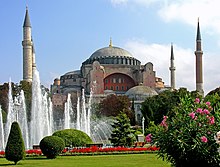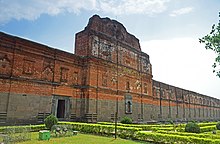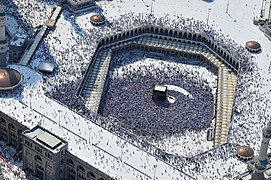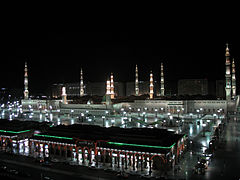
A | B | C | D | E | F | G | H | CH | I | J | K | L | M | N | O | P | Q | R | S | T | U | V | W | X | Y | Z | 0 | 1 | 2 | 3 | 4 | 5 | 6 | 7 | 8 | 9
| Part of a series on |
| Islam |
|---|
 |
A mosque (/mɒsk/ MOSK), also called a masjid (/ˈmæsdʒɪd, ˈmʌs-/ MASS-jid, MUSS-),[note 1] is a place of worship for Muslims.[1] The term usually refers to a covered building, but can be any place where Islamic prayers are performed, such as an outdoor courtyard.[2][3]
Originally, mosques were simple places of prayer for the early Muslims, and may have been open spaces rather than elaborate buildings.[4] In the first stage of Islamic architecture (650–750 CE), early mosques comprised open and closed covered spaces enclosed by walls, often with minarets, from which the Islamic call to prayer was issued on a daily basis.[5] It is typical of mosque buildings to have a special ornamental niche (a mihrab) set into the wall in the direction of the city of Mecca (the qibla), which Muslims must face during prayer,[1] as well as a facility for ritual cleansing (wudu).[1][6] The pulpit (minbar), from which public sermons (khutbah) are delivered on the event of Friday prayer, was, in earlier times, characteristic of the central city mosque, but has since become common in smaller mosques.[7][1] To varying degrees, mosque buildings are designed so that there are segregated spaces for men and women.[1] This basic pattern of organization has assumed different forms depending on the region, period, and Islamic denomination.[6]
In addition to being places of worship in Islam, mosques also serve as locations for funeral services and funeral prayers, marriages (nikah), vigils during Ramadan, business agreements, collection and distribution of alms, and homeless shelters.[1][7] To this end, mosques have historically been multi-purpose buildings functioning as community centres, courts of law, and religious schools. In modern times, they have also preserved their role as places of religious instruction and debate.[1][7] Special importance is accorded to, in descending order of importance: al-Masjid al-Haram in the city of Mecca, where Hajj and Umrah are performed; the Prophet's Mosque in the city of Medina, where Muhammad is buried; and al-Aqsa Mosque in the city of Jerusalem, where Muslims believe that Muhammad ascended to heaven to meet God around 621 CE.[1] There's a growing realization among scholars that the present-day perception of mosques doesn't fully align with their original concept. Early Islamic texts and practices highlight mosques as vibrant centers integral to Muslim communities, supporting religious, social, economic, and political affairs.[8]
During and after the early Muslim conquests, mosques were established outside of Arabia in the hundreds; many synagogues, churches, and temples were converted into mosques and thus influenced Islamic architectural styles over the centuries.[7] While most pre-modern mosques were funded by charitable endowments (waqf),[1] the modern-day trend of government regulation of large mosques has been countered by the rise of privately funded mosques, many of which serve as bases for different streams of Islamic revivalism and social activism.[7]
Etymology
The word 'mosque' entered the English language from the French word mosquée, probably derived from Italian moschea (a variant of Italian moscheta), from either Middle Armenian մզկիթ (mzkit‘), Medieval Greek: μασγίδιον (masgídion), or Spanish mezquita, from مسجد (meaning "site of prostration (in prayer)" and hence a place of worship), either from Nabataean masgĕdhā́ or from Arabic Arabic: سَجَدَ, romanized: sajada (meaning "to prostrate"), probably ultimately from Nabataean Arabic masgĕdhā́ or Aramaic sĕghēdh.[9]
History
Origins
Islam was established in Arabia during the lifetime of Muhammad in the 7th century CE.[10] The first mosque in history could be either the sanctuary built around the Ka'bah ('Cube') in Mecca, known today as Al-Masjid al-Haram ('The Sacred Mosque'), or the Quba Mosque in Medina, the first structure built by Muhammad upon his emigration from Mecca in 622 CE,[11] both located in the Hejaz region in present-day Saudi Arabia.[12]
Other scholars reference Islamic tradition[13][14][15] and passages of the Quran,[16][17][18] according to which Islam as a religion precedes Muhammad, and includes previous prophets such as Abraham.[19] In Islamic tradition, Abraham is credited with having built the Ka'bah in Mecca, and consequently its sanctuary, Al-Masjid al-Haram, which is seen by Muslims as the first mosque that existed.[20][21][22][23] A hadith in Sahih al-Bukhari states that the sanctuary of the Ka'bah was the first mosque on Earth, with the second mosque being Al-Aqsa in Jerusalem,[24] which is also associated with Abraham.[21] Since as early as 638 CE, the Sacred Mosque of Mecca has been expanded on several occasions to accommodate the increasing number of Muslims who either live in the area or make the annual pilgrimage known as Hajj to the city.[25]
Either way, after the Quba Mosque, Muhammad went on to establish another mosque in Medina, which is now known as Al-Masjid an-Nabawi ('The Prophet's Mosque'). Built on the site of his home, Muhammad participated in the construction of the mosque himself and helped pioneer the concept of the mosque as the focal point of the Islamic city.[26] The Prophet's Mosque is considered by some scholars of Islamic architecture to be the first mosque.[27][28] The mosque had a roof supported by columns made of palm tree trunks[29] and it included a large courtyard, a motif common among mosques built since then.[26] Rebuilt and expanded over time,[30] it soon became a larger hypostyle structure.[28] It probably served as a model for the construction of early mosques elsewhere.[27][28][29] It introduced some of the features still common in today's mosques, including the niche at the front of the prayer space known as the mihrab (first added in the Umayyad period)[30] and the tiered pulpit called the minbar.[31]
-
Aerial view of the Sacred Mosque (Al-Masjid Al-Ḥarām) of Mecca in Saudi Arabia, the largest mosque and holiest site in Islam, with the Kaaba in the center (2010 photo)
-
The Prophet's Mosque (al-Masjid an-Nabawi) in Medina, Islam's second holiest site
-
Masjid al-Qiblatayn (Mosque of the two Qiblahs) in Medina
-
The Al-Aqsa Mosque in Jerusalem, Islam's third holiest site
Diffusion and evolution

The Umayyad Caliphate was particularly instrumental in spreading Islam and establishing mosques within the Levant, as the Umayyads constructed among the most revered mosques in the region — Al-Aqsa Mosque and Dome of the Rock in Jerusalem, and the Umayyad Mosque in Damascus.[32] The designs of the Dome of the Rock and the Umayyad Mosque were influenced by Byzantine architecture, a trend that continued much later with the rise of the Ottoman Empire.[33]
The Great Mosque of Kairouan in present-day Tunisia was the first mosque built in the Maghreb (northwest Africa), with its present form (dating from the ninth century) serving as a model for other Islamic places of worship in the Maghreb. It was the first in the region to incorporate a square minaret, which was characteristic of later Maghrebi mosques, and includes naves akin to a basilica.[34][35] Those features can also be found in Andalusi mosques, including the Great Mosque of Cordoba, as they tended to reflect the architecture of the Moors instead of their Visigoth predecessors.[35] Still, some elements of Visigothic architecture, like horseshoe arches, were infused into the mosque architecture of Spain and the Maghreb.[36]

Muslim empires were instrumental in the evolution and spread of mosques. Although mosques were first established in India during the seventh century, they were not commonplace across the subcontinent until the arrival of the Mughals in the 16th and 17th centuries. Reflecting their Timurid origins, Mughal-style mosques included onion domes, pointed arches, and elaborate circular minarets, features common in the Persian and Central Asian styles.[37] The Jama Masjid in Delhi and the Badshahi Mosque in Lahore, built in a similar manner in the mid-17th century,[38] remain two of the largest mosques on the Indian subcontinent.[39]
The first mosque in East Asia was established in the eighth century in Xi'an. The Great Mosque of Xi'an, whose current building dates from the 18th century, does not replicate the features often associated with mosques elsewhere.[40] Minarets were initially prohibited by the state.[41] Following traditional Chinese architecture, the Great Mosque of Xi'an, like many other mosques in eastern China, resembles a pagoda, with a green roof instead of the yellow roof common on imperial structures in China. Mosques in western China were more likely to incorporate elements, like domes and minarets, traditionally seen in mosques elsewhere.[40]

A similar integration of foreign and local influences could be seen on the Indonesian islands of Sumatra and Java, where mosques, including the Demak Great Mosque, were first established in the 15th century.[42] Early Javanese mosques took design cues from Hindu, Buddhist, and Chinese architectural influences, with tall timber, multi-level roofs similar to the pagodas of Balinese Hindu temples; the ubiquitous Islamic dome did not appear in Indonesia until the 19th century.[41][43] In turn, the Javanese style influenced the styles of mosques in Indonesia's Austronesian neighbors—Malaysia, Brunei, and the Philippines.[42]
Several of the early mosques in the Ottoman Empire were originally churches or cathedrals from the Byzantine Empire, with the Hagia Sophia (one of those converted cathedrals) informing the architecture of mosques from after the Ottoman conquest of Constantinople.[44] The Ottomans developed their own architectural style characterized by large central domes (sometimes surrounded by multiple smaller domes), pencil-shaped minarets, and open façades.[45]

Mosques from the Ottoman period are still scattered across Eastern Europe, but the most rapid growth in the number of mosques in Europe has occurred within the past century as more Muslims have migrated to the continent. Many major European cities are home to mosques, like the Grand Mosque of Paris, that incorporate domes, minarets, and other features often found with mosques in Muslim-majority countries.[46] The first mosque in North America was founded by Albanian Americans in 1915, but the continent's oldest surviving mosque, the Mother Mosque of America, was built in 1934.[47] As in Europe, the number of American mosques has rapidly increased in recent decades as Muslim immigrants, particularly from South Asia, have come in the United States. Greater than forty percent of mosques in the United States were constructed after 2000.[48]
Inter-religious conversion

According to early Muslim historians, towns that surrendered without resistance and made treaties with the Muslims were allowed to retain their churches and the towns captured by Muslims had many of their churches converted to mosques.[49] One of the earliest examples of these kinds of conversions was in Damascus, Syria, where in 705 Umayyad caliph Al-Walid I bought the church of St. John from the Christians and had it rebuilt as a mosque in exchange for building a number of new churches for the Christians in Damascus. Overall, Abd al-Malik ibn Marwan (Al-Waleed's father) is said to have transformed 10 churches in Damascus into mosques.[50]
The process of turning churches into mosques were especially intensive in the villages where most of the inhabitants converted to Islam.[citation needed] The Abbasid caliph al-Ma'mun turned many churches into mosques. Ottoman Turks converted nearly all churches, monasteries, and chapels in Constantinople, including the famous Hagia Sophia, into mosques immediately after capturing the city in 1453. In some instances mosques have been established on the places of Jewish or Christian sanctuaries associated with Biblical personalities who were also recognized by Islam.[51]
Mosques have also been converted for use by other religions, notably in southern Spain, following the conquest of the Moors in 1492.[52] The most prominent of them is the Great Mosque of Cordoba, itself constructed on the site of a church demolished during the period of Muslim rule. Outside of the Iberian Peninsula, such instances also occurred in southeastern Europe once regions were no longer under Muslim rule.
Religious functions
Prayers
There are two holidays (Eids) in the Islamic calendar: ʿĪd al-Fiṭr and ʿĪd al-Aḍḥā, during which there are special prayers held at mosques in the morning. These Eid prayers are supposed to be offered in large groups, and so, in the absence of an outdoor Eidgah, a large mosque will normally host them for their congregants as well as the congregants of smaller local mosques. Some mosques will even rent convention centers or other large public buildings to hold the large number of Muslims who attend. Mosques, especially those in countries where Muslims are the majority, will also host Eid prayers outside in courtyards, town squares or on the outskirts of town in an Eidgah.[53][54]
Ramadan

Islam's holiest month, Ramaḍān, is observed through many events. As Muslims must fast during the day during Ramadan, mosques will host Ifṭār dinners after sunset and the fourth required prayer of the day, that is Maghrib. Food is provided, at least in part, by members of the community, thereby creating daily potluck dinners. Because of the community contribution necessary to serve iftar dinners, mosques with smaller congregations may not be able to host the iftar dinners daily. Some mosques will also hold Suḥūr meals before dawn to congregants attending the first required prayer of the day, Fajr. As with iftar dinners, congregants usually provide the food for suhoor, although able mosques may provide food instead. Mosques will often invite poorer members of the Muslim community to share in beginning and breaking the fasts, as providing charity during Ramadan is regarded in Islam as especially honorable.[55]
Following the last obligatory daily prayer (ʿIshāʾ) special, optional Tarāwīḥ prayers are offered in larger mosques. During each night of prayers, which can last for up to two hours each night, usually one member of the community who has memorized the entire Quran (a Hafiz) will recite a segment of the book.[56] Sometimes, several such people (not necessarily of the local community) take turns to do this. During the last ten days of Ramadan, larger mosques will host all-night programs to observe Laylat al-Qadr, the night Muslims believe that Muhammad first received Quranic revelations.[56] On that night, between sunset and sunrise, mosques employ speakers to educate congregants in attendance about Islam. Mosques or the community usually provide meals periodically throughout the night

During the last ten days of Ramadan, larger mosques within the Muslim community will host Iʿtikāf, a practice in which at least one Muslim man from the community must participate. Muslims performing itikaf are required to stay within the mosque for ten consecutive days, often in worship or learning about Islam. As a result, the rest of the Muslim community is responsible for providing the participants with food, drinks, and whatever else they need during their stay.[56]
Charity

The third of the Five Pillars of Islam states that Muslims are required to give approximately one-fortieth of their wealth to charity as Zakat.[57] Since mosques form the center of Muslim communities, they are where Muslims go to both give zakat and, if necessary, collect it. Before the holiday of Eid ul-Fitr, mosques also collect a special zakat that is supposed to assist in helping poor Muslims attend the prayers and celebrations associated with the holiday.
Frequency of attendance
The frequency by which Muslims attend mosque services vary greatly around the world. In some countries, weekly attendance at religious services is common among Muslims while in others, attendance is rare. A study of American Muslims did not find differences in mosque attendance by gender or age.[58]
Text je dostupný za podmienok Creative Commons Attribution/Share-Alike License 3.0 Unported; prípadne za ďalších podmienok. Podrobnejšie informácie nájdete na stránke Podmienky použitia.
Antropológia
Aplikované vedy
Bibliometria
Dejiny vedy
Encyklopédie
Filozofia vedy
Forenzné vedy
Humanitné vedy
Knižničná veda
Kryogenika
Kryptológia
Kulturológia
Literárna veda
Medzidisciplinárne oblasti
Metódy kvantitatívnej analýzy
Metavedy
Metodika
Text je dostupný za podmienok Creative
Commons Attribution/Share-Alike License 3.0 Unported; prípadne za ďalších
podmienok.
Podrobnejšie informácie nájdete na stránke Podmienky
použitia.
www.astronomia.sk | www.biologia.sk | www.botanika.sk | www.dejiny.sk | www.economy.sk | www.elektrotechnika.sk | www.estetika.sk | www.farmakologia.sk | www.filozofia.sk | Fyzika | www.futurologia.sk | www.genetika.sk | www.chemia.sk | www.lingvistika.sk | www.politologia.sk | www.psychologia.sk | www.sexuologia.sk | www.sociologia.sk | www.veda.sk I www.zoologia.sk




